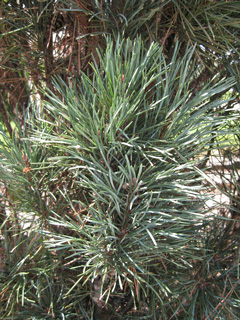Resource Library
Plant of the Week: Pine, Scotch
Plant of the Week
Scotch Pine
Latin: Pinus sylvestris
 Though once widely planted in landscapes and used extensively in Christmas tree plantation,
Scotch pine has largely disappeared from the South. (Image courtesy Gerald Klingaman)
Though once widely planted in landscapes and used extensively in Christmas tree plantation,
Scotch pine has largely disappeared from the South. (Image courtesy Gerald Klingaman)
During class reunion season it is not uncommon to hear the refrain “Whatever happened to old so and so?” The same thing happens in our gardens. Once common plants you encountered at every turn seem to just disappear. One that has disappeared from the gardening scene is Scotch pine (Pinus sylvesteris).
Scotch pine is probably the most widely distributed pine in the world with a range in northern Europe from its homeland in the British Isles east to Siberia and, along the mountainous regions of the continent south to Spain and the Caucasus. It is well suited to barren soils and cold climates, growing well north of the Arctic Circle. In the Siberian mountains it has survived temperatures as low as minus 65 degrees Fahrenheit and grows in regions where the permafrost never thaws.
As a forest tree it grows to 60 feet tall with hard, dense wood, at least for a pine. In the open, it retains its branches to the ground forming broad, rounded, often picturesque forms. Young trees have flaky, orange tinted bark. It is one of the two-needle pines with the needles about 2.5 inches long, twisted spirally and with a pair of white bands on the underside of each needle.
The most common leaf color, based on the original seed source, is blue-gray but some selections have normal green foliage while others have a yellow-green cast to the foliage.
Scotch pine, called Scots pine in Europe, has long been cultivated and used extensively in reforestation and land reclamation efforts. It is first mentioned in the Americas by John Bartram in 1760 but was likely introduced to the New England states prior to that time. It is a pine that thrives in a continental climate so it has done best in the United States in the upper Midwest in the states surrounding the Great Lakes.
In the 1960s and 70s, Scotch pine was a common component of the nursery trade, primarily being sold as small to mid-sized balled and burlapped trees. The trees survived transplanting well, they would grow in a wide array of soil types and they tolerated high rainfall areas as well as near desert climates with only a few inches of rainfall a year. While not the most common landscape pine in the South, it was widely planted throughout zones 7 and 8 and fairly commonly seen throughout Arkansas.
It has been widely planted for the Christmas tree market and, primarily supplied by northern growers, is reported to be the 5thmost popular species of cut tree.
In the mid 1980s, disaster struck. A little known pest – the pinewood nematode – began killing Scotch pines across much of the South and Midwest. The nematode, a microscopic worm, invades trees that are in drought stress and quickly kills the tree, often with the tree going from apparently healthy to graveyard dead in less than a month in midsummer.
The reproduction rate of the nematode is incredibly fast with the life cycle being completed in as little as four days. The nematode feeds on the fungal spores and mycelium of decaying pine wood and is transmitted by pine bark beetles. The disease is apparently native to North America and, amongst the pines, only our native slash pine, Scotch pine, Austrian pine and a couple Japanese species are susceptible to the pest. In a two-year period in the 1980s the Scotch pines and the Japanese black pines disappeared from Arkansas landscapes.
Scotch pines will probably never reappear in the Southern landscape as a common offering. Cultivars of it are occasionally encountered in nurseries, primarily shipped in from Pacific Northwest propagators who specialize in dwarf and slow growing conifers. Specialist collectors have selected over 50 clones of this species and maintain them by cuttings or grafting. There is no reason to suspect these cultivars have resistance to the disease, but because the epidemic has passed and because the loss of a small dwarf conifer from a collection will have little impact on the landscape, I see no reason they should not be planted.
(680 words )
By: Gerald Klingaman, retired
Retired Extension Horticulturist - Ornamentals
Extension News - July 18, 2014
The University of Arkansas System Division of Agriculture does not maintain lists of retail outlets where these plants can be purchased. Please check your local nursery or other retail outlets to ask about the availability of these plants for your growing area.